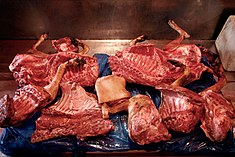
Back لحم الكلب Arabic কুকুৰৰ মাংস Assamese Karneng ayam BCL Кучешко месо Bulgarian কুকুরের মাংস Bengali/Bangla Psí maso Czech Hundefleisch German Hundoviando Esperanto Carne de perro Spanish گوشت سگ Persian
 Various cuts of dog meat | |
| Nutritional value per 100 g (3.5 oz) | |
|---|---|
| Energy | 1,096 kJ (262 kcal) |
0.1 g | |
| Dietary fiber | 0 g |
20.2 g | |
19 g | |
| Vitamins | Quantity %DV† |
| Vitamin A equiv. | 0% 3.6 μg |
| Thiamine (B1) | 10% 0.12 mg |
| Riboflavin (B2) | 14% 0.18 mg |
| Niacin (B3) | 12% 1.9 mg |
| Vitamin C | 3% 3 mg |
| Minerals | Quantity %DV† |
| Calcium | 1% 8 mg |
| Iron | 16% 2.8 mg |
| Phosphorus | 13% 168 mg |
| Potassium | 9% 270 mg |
| Sodium | 3% 72 mg |
| Other constituents | Quantity |
| Water | 60.1 g |
| Cholesterol | 44.4 mg |
| Ash | 0.8 g |
| †Percentages estimated using US recommendations for adults,[2] except for potassium, which is estimated based on expert recommendation from the National Academies.[3] Source: Yong-Geun Ann (1999)[1] | |
Dog meat is the flesh and other edible parts derived from dogs. Historically human consumption of dog meat has been recorded in many parts of the world.[4]
In the 21st century dog meat is consumed to a limited extent in Korea, China,[5] Indonesia, Nigeria,[6] Switzerland,[7] Vietnam,[8] and India;[9] it is eaten or is legal to be eaten in other countries throughout the world. Some cultures view the consumption of dog meat as part of their traditional, ritualistic, or day-to-day cuisine, and other cultures consider consumption of dog meat a taboo, even where it had been consumed in the past. Opinions also vary drastically across different regions within different countries.[10][11] It was estimated in 2014 that worldwide, 27 million dogs are eaten each year by humans.[12]
- ^ Ann Yong-Geun "Dog Meat Foods in Korea" Archived 7 October 2007 at Wikiwix, Bosintang (in 100 g, raw meat), Korean Journal of Food and Nutrition 12(4) 397 – 408 (1999).
- ^ United States Food and Drug Administration (2024). "Daily Value on the Nutrition and Supplement Facts Labels". Retrieved 28 March 2024.
- ^ National Academies of Sciences, Engineering, and Medicine; Health and Medicine Division; Food and Nutrition Board; Committee to Review the Dietary Reference Intakes for Sodium and Potassium (2019). Oria, Maria; Harrison, Meghan; Stallings, Virginia A. (eds.). Dietary Reference Intakes for Sodium and Potassium. The National Academies Collection: Reports funded by National Institutes of Health. Washington, DC: National Academies Press (US). ISBN 978-0-309-48834-1. PMID 30844154.
- ^ Schwabe, Calvin W. (1979). Unmentionable cuisine. University of Virginia Press. p. 168. ISBN 978-0-8139-1162-5.
- ^ Rupert Wingfield-Hayes (29 June 2002). "China's taste for the exotic". BBC News. Retrieved 15 May 2007.
- ^ Cite error: The named reference
BBCNigeriawas invoked but never defined (see the help page). - ^ "Not Just for Christmas: Swiss Urged to Stop Eating Cats and Dogs". Newsweek. 26 November 2014.
Hundreds of thousands of people in Switzerland eat cat and dog meat, particularly at Christmas, according to a Swiss animal rights group seeking to ban the practice.
- ^ "Vietnam's dog meat tradition". BBC News. 31 December 2001. Retrieved 15 May 2007.
- ^ Cite error: The named reference
:1was invoked but never defined (see the help page). - ^ Cite error: The named reference
Times1940was invoked but never defined (see the help page). - ^ Cite error: The named reference
Mawsonwas invoked but never defined (see the help page). - ^ Czajkowski, C. (2014). "Dog meat trade in South Korea: A report on the current state of the trade and efforts to eliminate it". Animal Law. 21: 29–151. Archived from the original on 11 June 2017. Retrieved 24 June 2015.
© MMXXIII Rich X Search. We shall prevail. All rights reserved. Rich X Search